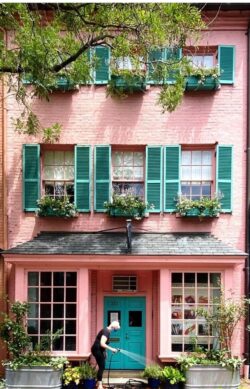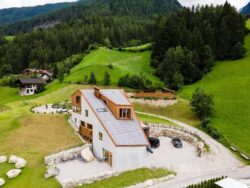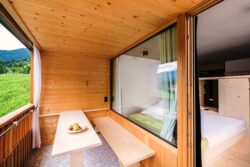Read Time: 6 Minutes Subscribe & Share
Not Ready For Prime Time
 I made a faint inquiry many years ago about putting solar panels on the slate roof of our house on Cameron Street. It’s a house with a historic property plaque (1810 is the suggested building date) and my feeble request was met with a stern No. If James Madison didn’t have solar panels, neither will you. But I have often wondered about what an environmentally friendly house, with the use of local materials, would look like, feel like, be like. After all, even in our plaqued house, you could see the broken oyster shells from the Potomac River in the mortar of our Virginia brick walls. We certainly had local heart-of-pine wood flooring. The insulation between floors was grain, which fell to the pine floors when we opened the ceiling to install light fixtures.
I made a faint inquiry many years ago about putting solar panels on the slate roof of our house on Cameron Street. It’s a house with a historic property plaque (1810 is the suggested building date) and my feeble request was met with a stern No. If James Madison didn’t have solar panels, neither will you. But I have often wondered about what an environmentally friendly house, with the use of local materials, would look like, feel like, be like. After all, even in our plaqued house, you could see the broken oyster shells from the Potomac River in the mortar of our Virginia brick walls. We certainly had local heart-of-pine wood flooring. The insulation between floors was grain, which fell to the pine floors when we opened the ceiling to install light fixtures.
We sold our building in Old Town, Alexandria, which housed both the shop and our apartment above – as well as the RWM’s wine cellar in the ice house/coal cellar of our basement. We hope to buy an apartment in the Centro Storico of Bologna. It has loads of 16th and 17th century palazzi as well as post-war apartment buildings jutting out in various neighborhoods that had been heavily bombed by the Allies in WWII – Bologna was a strategic commercial crossroads used by the German military. Now in the dawn of the 21st century (and a reckoning with climate change) the EU has laid out environmental goals for both public and private buildings. We certainly want to take advantage of the many Green building incentives (and also avoid penalties for not meeting the 2030 energy standards set by the Italian government). Obviously, solar panels on buildings abound in Italy.
A New Housing Generation
So when we saw that this particular house in Valle Aurina was available for our dream trip, which I wrote about in a previous post, we were intrigued. As you can imagine, many of the guest offerings in this area look like they housed an upscale Hansel and Gretel. In addition, we did not want a hotel, even with pool and other typical hospitality amenities, but rather a place we could call our own. This unusual offering boasted a lawn with swings and slides, a climbing wall (Alto Adige citizens take mountain sports very seriously – you can visit a series of museums dedicated to Reinhold Messner, the world famous mountain climber), a basketball hoop, ping pong table, volleyball net, even a cave and a circle of boulders, just waiting to be climbed. It had a grill and firepit combination like nothing we had ever seen before, and the architecture was simply out of this world.
about in a previous post, we were intrigued. As you can imagine, many of the guest offerings in this area look like they housed an upscale Hansel and Gretel. In addition, we did not want a hotel, even with pool and other typical hospitality amenities, but rather a place we could call our own. This unusual offering boasted a lawn with swings and slides, a climbing wall (Alto Adige citizens take mountain sports very seriously – you can visit a series of museums dedicated to Reinhold Messner, the world famous mountain climber), a basketball hoop, ping pong table, volleyball net, even a cave and a circle of boulders, just waiting to be climbed. It had a grill and firepit combination like nothing we had ever seen before, and the architecture was simply out of this world.
Shop Carbon Neutral
As this area is famous for its timber and stone, we knew that this unusual house would certainly highlight the use of these materials. We just did not realize how much. It also boasts the certification of CasaClima – a most unusual quality assurance agency with its offices centered in Bolzano in Alto Adige.
The CasaClima Agency is a center of excellence for energy-efficient and sustainable construction and renovation that is widely recognized throughout Italy and now increasingly also on an international level. As a pioneering institution in this field, CasaClima has been constantly evolving its standards since 2002, and has created a wide range of quality seals for building products and building certifications that describe sustainable construction in a more holistic approach.
 CasaClima has always been strongly committed to awareness-raising and consultancy activities for building owners and citizens. A very central pillar is also the education and training of planners and craftsmen on the topics of energy-efficient and sustainable methods and products.
CasaClima has always been strongly committed to awareness-raising and consultancy activities for building owners and citizens. A very central pillar is also the education and training of planners and craftsmen on the topics of energy-efficient and sustainable methods and products.
Koasa Hof’s owners live on the top level of the house you see in these photographs. Markus Weger is a passionate reader of architecture books and the house reflects this devotion. The Koasa Hof has a cleverly designed library in its hallway and an antique trolley displaying the area’s brochures and maps – and there are plenty on offer. Plus, the house is an amazing design in its simplicity and sensibility.
Koasa Hof (Koasa is old Sud Tirol dialect for Kaiser) makes good use of the region’s stone and timber. The walls are cement panels – wiring is embedded within – and you can see both dry stone work and stone and mortar features in and around the house. The bedrooms and their furnishings are entirely minimalist, designed in wood. The toilets are in a separate room from the shower room – which reminded me of my stay in Germany… although with the required Italian bidet. Interesting note, all showers had a men’s urinal in its spacious confines. Markus told us that he and his wife could not make up their minds about tile, so in frustration he bought a large block of marble, had it cut for bathroom walls and flooring, and used the debris for floors on his decks. Each deck, instead of being an exterior addition, was an integral part of each bedroom.
although with the required Italian bidet. Interesting note, all showers had a men’s urinal in its spacious confines. Markus told us that he and his wife could not make up their minds about tile, so in frustration he bought a large block of marble, had it cut for bathroom walls and flooring, and used the debris for floors on his decks. Each deck, instead of being an exterior addition, was an integral part of each bedroom.
Precast concrete walls with wiring encased within and heating in the floors and windows placed to take advantage of light and temperature changes were designed and made locally. Wood, which Markus said with a smile, he had plenty of access to, made up all the furnishings in each guest room – bed frames, shelving, seating areas, A spare single bed in most rooms housed a twin bed frame (in wood of course) that could be hoisted to make it into a bunk bed. The wood ladders for them were a decoration on the wall as well. Each room was WiFi ready, with nifty Italian reading lamps. The house was placed so that the wood shingles on the roof could dry out with the proper exposure to the sun. The kitchen and dining area opened onto a beautiful patio with the magnificent grill,
 Markus said once the materials were chosen, the design evolved on the principles of how best to use them. His great grandparents, he told us, owned the property. Since local zoning laws required that the house be located no less than several meters from the road, he had the narrowest part of the house start at the designated mark and then the rest of the architectural design fans out from that point. The furnishings from his grandmother’s general store were folded into this great room and used for storage and counter areas. Simplicity did not ignore attention to detail. Even in the sauna, its window was aligned with an exterior window precisely to give you an incredible mountain view.
Markus said once the materials were chosen, the design evolved on the principles of how best to use them. His great grandparents, he told us, owned the property. Since local zoning laws required that the house be located no less than several meters from the road, he had the narrowest part of the house start at the designated mark and then the rest of the architectural design fans out from that point. The furnishings from his grandmother’s general store were folded into this great room and used for storage and counter areas. Simplicity did not ignore attention to detail. Even in the sauna, its window was aligned with an exterior window precisely to give you an incredible mountain view.
A glance at his woodshed/workshop tells you that he uses wood as decor as well as for heating and building. There is a chicken coop (really a small castello, similar to the one Nils built) and little hutch for bunnies who roam freely, and a special gated community for his quail. We had plans to try restaurants in the area, but with this irresistible grill, which seduced the entire male contingent of our group, we planned dinners around it almost every evening. With the sensational views, the invigorating mountain air, and this impressively designed and welcoming house, who would want to leave?

Kitchen Detail shares under the radar recipes, explores the art of cooking, the stories behind food, and the tools that bring it all together, while uncovering the social, political, and environmental truths that shape our culinary world.




Hi Nancy, I just subscribed because a friend sent a snippet of this post to me. I am a former Alexandrian, we used to live in Old Town North. I was also a customer at La Cuisine because I love to cook. I also wanted to mention I retired to Italy as you intimated you also planned to do. We have lived in Umbria for 10 years. Anyway, wanted to introduce myself and I look forward to your posts.
Hello Nancy!
So delighted to make your acquaintance! Bologna is our home now and we are still looking to buy an apartment – so many new ingredients to cook with!. I hope we can connect in the new future since you live in Umbria.
Nancy